NASA astronauts moonwalk in the dark in preparation for Artemis
February 26, 2022
NASA astronauts are preparing for the Artemis mission, in which they will explore the moon’s south pole, by training underwater with the lights out.
At the NASA Neutral Buoyancy Laboratory in Texas, training is taking place in a 40.5-feet deep pool where all the lights are turned off and black curtains surround the pool walls.
“Kill the lights – we’re simulating a Moonwalk!” NASA’s Johnson Space Center tweeted along with a photo of astronauts training in the dark pool. “Divers at NASA’s Neutral Buoyancy Laboratory turned off the lights to simulate what an Artemis astronaut might experience at the lunar south pole – long, dark shadows.”
The Artemis mission is NASA’s plan to return humans to the moon by 2024, which has not occurred since the Apollo 17 mission in 1972.
The difference between the Artemis program and Apollo 17 is that the former targets the moon’s south pole.
The moon’s south pole is not only extremely cold and dark, but scientists believe its cavernous craters, regions without sunlight, might be storehouses for frozen water. NASA seeks to land humans on the moon to search the south poles for water and other resources, according to Inverse.
Before the lunar landing, NASA plans to launch two other missions to the moon to test its new Orion capsule.
The first mission, Artemis 1, will send the Orion spacecraft on a loop for three days around the moon without any passengers. This will test the capsule’s ability to fly to the moon and back.
The second mission is Artemis 2, which will be the first test with passengers on the Orion and Space Launch System, SLS, rocket. The Orion capsule will carry four astronauts around the moon’s far side, the farthest humans have traveled into space, Insider reported.
Once the spacecraft reaches its destination point, the gravity between the moon and Earth will bring the spacecraft back. The mission is expected to take 10 days.
For the Artemis 3 mission, NASA has worked on new spacesuits that are more flexible across the body than the suits the Apollo 17 astronauts wore. It will also include improved in-helmet communications systems to help automatically pick up the astronaut’s voice when speaking to crewmates.
The program is relying on just over $3 billion from the U.S. Congress to build the landing system.
“The budget request that we have before the House and the Senate right now includes $3.2 billion for 2021 for the human landing system. It is critically important that we get that $3.2 billion,” NASA Administrator Jim Bridenstine said in September 2020, according to BBC.
NASA has called the Artemis mission the “new era of lunar exploration” that plans to explore regions of the moon never explored before and open the possibility of human exploration on Mars.
“I am proud to share NASA’s Artemis Plan—this is how we will go to the Moon once again. And how we will use the Moon as the stepping stone for our next greatest leap—human exploration of Mars,” Bridenstine wrote in the Artemis Plan report.








